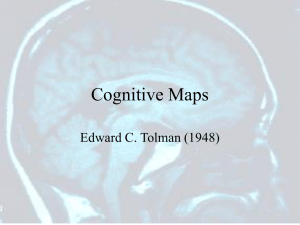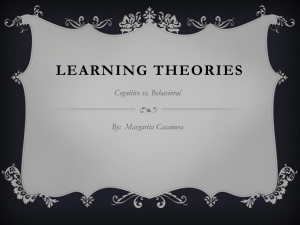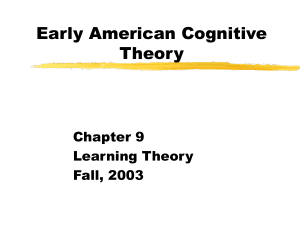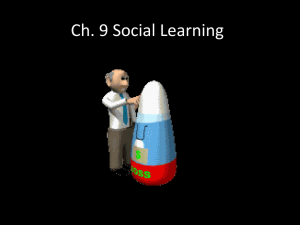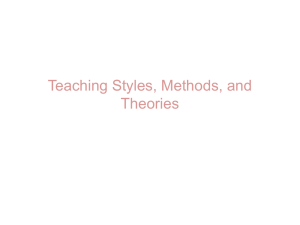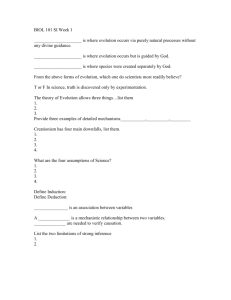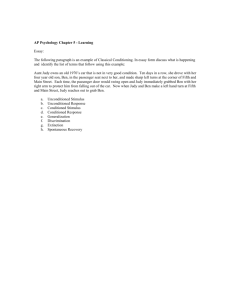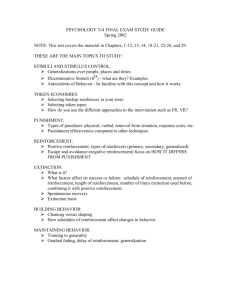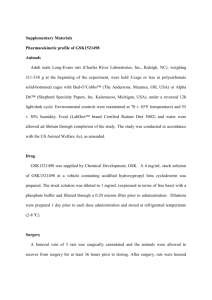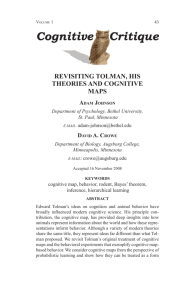Edward C. Tolman
advertisement
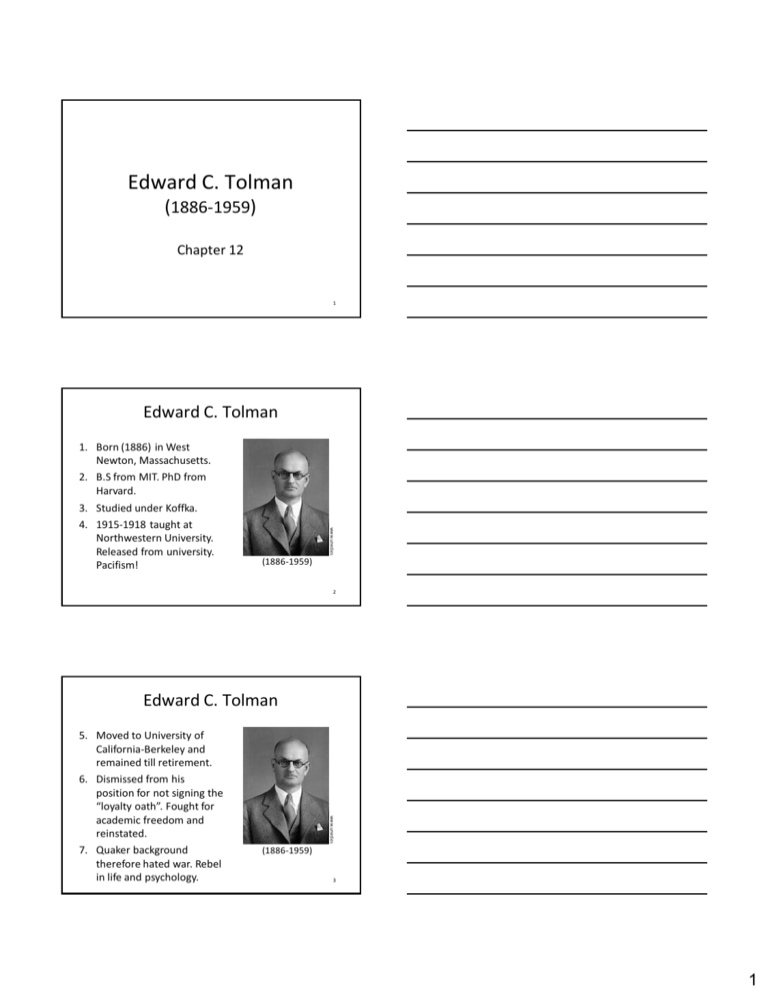
Edward C. Tolman (1886-1959) Chapter 12 1 Edward C. Tolman 1. Born (1886) in West Newton, Massachusetts. 2. B.S from MIT. PhD from Harvard. www.uned.es 3. Studied under Koffka. 4. 1915-1918 taught at Northwestern University. Released from university. Pacifism! (1886-1959) 2 Edward C. Tolman www.uned.es 5. Moved to University of California-Berkeley and remained till retirement. 6. Dismissed from his position for not signing the “loyalty oath”. Fought for academic freedom and reinstated. 7. Quaker background therefore hated war. Rebel in life and psychology. (1886-1959) 3 1 Edward C. Tolman 8. www.uned.es Did not believe in the unit of behavior pursued by Pavlov, Guthrie, Skinner and Hull. “Twitchism” vs. molar behavior. 9. Learning theory a blend of Gestalt psychology and behaviorism. 10. Died 19 Nov. 1959. (1886-1959) 4 Comparison of Schools Behaviorism Behaviorists believed in “elements” of S-R associations. Observation and Experimentation Approach: Behavioral Gestalt Gestalt psychologists believed in the “whole” mind or mental processes. Observation, Experimentation and Introspection Approach: Cognitive 5 Tolman’s idea about behavior 1. Conventional behaviorists do not explain phenomena like knowledge, thinking, planning, inference, intention and purpose in animals. In fact, they do not believe in mental phenomena like these. 2. Tolman on the other hand describes animal behavior in all of these terms and takes a “Gestalt” viewpoint on behavior, which is to look at behavior in molar or holistic terms. 6 2 Tolman’s idea about behavior 3. So rat running a maze, cat escaping the puzzle box and a man talking on the phone are all molar behaviors. 4. All molar behaviors have a purpose, and that purpose is goal-directed. So Tolman explains molar behavior in terms of goal-directed (meaningful) activity. 5. Tolman then is a neobehavioristic whose brand of behaviorism is called purposive behaviorism. 7 Differences Behaviorism Purposive Behaviorism Pavlov, Watson, Thorndike, Guthrie, Skinner and Hull proposed S-R associations meant learning. Tolman suggested, S-R associations were not beneficial for analyzing learning. Instead analysis of S-S associations were important in understanding learning. Study molecular behaviors. Study molar behaviors. Don’t explain behavior. Behavior is goal-directed. 8 Similarities Behaviorism Purposive Behaviorism Both agree that study of animal behavior is important not the study of animal “mind”. Both believe in observation and experimentation as a method of study, not introspection. 9 3 Latent Learning To show rats can learn by exposure (latent learning), Blodgett (1929) took three groups of rats and allowed them to explore 6 unit alley T-maze. One group was not reinforced at all, the other two were reinforced after 3 and 7 days. 10 Latent Learning: Results Average Errors Two experimental groups reinforced after 3 (G3) and after 7 (G2) days, showed sudden and marked reduction in errors. Latent learning revealed itself after reinforcement was introduced. Learning took place early on in the training for G3 group. 5.0 4.5 4.0 3.5 3.0 2.5 2.0 1.5 1.0 0.5 0.0 Reinforced Day 3 (G3) Reinforced Day 7 (G2) Regularly Reinforced (G1) 1 2 3 4 5 6 7 8 9 11 Days Latent Learning Tolman and Honzik (1930) in a 14 unit alley T-maze, replicated Blodgett (1929) study and concluded that rats learnt latently while exploring the maze. 12 4 Latent Learning: Results 12 Regularly Reinforced Average Errors 10 Reinforced Day 11 No Reinforcement 8 6 4 2 0 1 2 3 4 5 6 7 8 9 10 11 12 13 14 15 16 17 Days 1. Reinforced group (green) shows steady improvement in performance. 2. For the reinforcement day 11 group (red) sudden improvement in performance is observed after 11th day. 13 No Reinforcement Group 3. A slight improvement in performance of no reinforcement group (blue) was also observed. 4. According to behaviorists (chiefly Hull), rats were getting reinforcement because they were removed from the maze after reaching the goal box. 5. Tolman and Spence disagreed, they said that this slight improvement in performance was starkly miniscule to the enormous improvement in the reinforcement day 11 group (red). 14 What is latent learning? 1. Latent learning (like Guthrie) was an ongoing process in rat or man, that did not require motivation or reinforcement. 2. Motivation did indeed attract the attention of the hungry animal. Therefore it acted as a perceptual emphasizer. 3. Learning then was different from performance. The organism knows (learns) about the environment, but acts (performs) on it, only when the need (reinforcement) arises. 15 5 Vicarious Trial & Error (VTE) 1. VTE refers to that hesitating look observed in rats and humans (king-forth-and-back), at a choice-point where the animal “thinks” about going one way or the other, before it actually does go, one way or the other (Muenzinger, 1938). 2. Animals (including humans) make a mental (vicarious) trial and error before they make a behavioral trial and error response. 16 Experimental Apparatuses Experiments with VTE involved classical and more modern apparatuses, used in visual discrimination procedures (Lashley, 1930; Tolman, 1948). 17 Visual Discrimination 1. To study VTE and associated run, Tolman and his colleagues trained rats to visually discriminate among three sets of stimuli. Between a white and a black door (easy), between a white and a medium grey door (harder), and between a white and a light grey door (hardest). 18 6 Visual Discrimination 2. For the easy task (White-Black) rats took fewer days to learn the discrimination than harder (White-Medium Grey) or the hardest (WhiteLight Grey) task. 6 Correct Runs 5 4 3 2 White-Black Discrimination White-Medium Grey Discrimination 1 White-Light Grey Discrimination 0 1 2 3 4 5 6 7 8 9 10 11 12 13 14 15 16 17 18 19 20 Days 19 Visual Discrimination VTEs Average VTEs 3. For the easy task (White-Black) the rats made more VTEs than harder (White-Medium Grey) or the hardest (White-Light Grey) task. 22 20 18 16 14 12 10 8 6 4 2 0 White-Black Discrimination White-Medium Grey Discrimination White-Light Grey Discrimination 1 2 3 4 5 6 7 8 9 10 11 12 13 14 15 16 17 18 19 20 Days 20 VTEs: Conclusions 1. Rats were able to select and compare stimuli early on for the easy task; made more VTEs, and correct runs. For harder tasks they took more trials before they could make more VTEs and more accurate runs. It takes rats many more trials to make fine discriminations between white and grey doors. 2. Accurate discriminations (VTEs) and effective runs further support the idea of building cognitive maps. 21 7 Response Learning 1. Conventional behaviorists emphasize S-R learning, i.e., animals learn a specific response(s). Tolman and colleagues showed that response learning was difficult and took longer time for the animals to acquire. 22 Place Learning 2. Tolman and colleagues clearly showed place learning was much easier to learn. Rats made fewer errors and learnt the task in fewer trials. Cognitive maps were easily formed and rats rerouted their paths to reach the goal. 23 Results Total Errors/Group (N = 8) Data suggested that rats that learnt a place made fewer errors and reached zero errors on the 9th trial, whereas response learners continued to make errors to the end. 8 7 6 5 4 3 2 1 0 -1 Response Learning Place Learning 1 3 5 7 9 11 13 15 17 19 21 23 25 27 29 31 33 Trials 24 8 Place Learning In the training period, rats learned the maze from A to G. In the testing phase, the maze was changed to a sun-burst pattern, alley C-D was blocked and a choice was given to select alleys 1-12. 25 Results Since alley 6 spatially matched up with the goal box of the maze in the testing period. This alley was maximally selected by a large percentage of rats. 40 34.0 Percentage of Rats 35 30 25 20 17.0 15 7.5 10 5 2.0 4.0 7.5 8.0 6.0 4.0 4.0 2.0 2.0 0 12 11 10 9 8 7 6 5 4 3 2 1 Pathway 26 Cognitive Map 1. For Tolman, place learning lead to development of comprehensive cognitive map of the maze. 2. Cognitive map is a selective mental map, a “broad” picture of the environment, which develops by environmental exploration. 3. Once “the lay of the land” (cognitive map) is developed, the animal can reach its goal from any direction, individual responses, even individual routes to goal do not matter. 27 9 Hypotheses Krech and Tolman (1932) used a complicated maze to study how rats used strategies (hypotheses) to reach the goal box. They changed the colors of the doors (dark, light), making them swing or freeze etc. 28 Hypotheses and Beliefs 1. Results form this study suggested that rats used complicated strategies in developing their cognitive maps, going from where to find what (including the goal). 2. Tentative expectations (early strategies), in cognitive map development are called hypotheses. 3. A hypothesis that is consistently confirmed becomes a belief. The animal “believes” where a certain object will be, or what action will lead to what. 29 Hypotheses and Beliefs 4. Just as mechanisms of hypotheses and beliefs lead to latent learning, their violations lead to latent extinction of behaviors. 5. Tolman suggested that the rat stops going to the goal box because he does not believe that reinforcement is there. This idea is contrary to SR theorists who argue, removal of reinforcement (food) leads to extinction of a response. 30 10 Latent Extinction 6. Latent extinction refers to decrease in responses which occur as a result of non-reinforced experience in the goal box. Rats trained in a maze with reinforcement in goal box, were then placed directly into an empty goal box by the experimenter. Rats when reintroduced into the maze showed hesitant responses to go to the goal box for they did not expect the reinforcement. 31 Reinforcement Expectancy 1. For Tolman, changing reinforcement meant change in expectations and thus performance. Switching from one reward to another changes expectations which can favorably or adversely affect performance (Elliot, 1932). 2. For S-R theorists changing comparable reinforcements would not bring a change in behavior. Learning would be equivalent across reinforcing conditions. 32 Results Rats in the bran mush group did consistently better than the sunflower seed group. When diet for bran mush group changed, their expectations changed, and thus their performance. 10 9 Bran Mush (Experimental Group) 8 Sunflower Seed (ControlGroup) Average Errors 7 6 5 4 3 2 1 0 1 2 3 4 5 6 7 8 9 10 11 12 13 14 15 16 17 18 33 DailyTrials 11 Conclusions 1. Hullians would argue that the incentive (K) value of bran mush was higher than sunflower seeds, so when bran mush group was given sunflower seeds to eat, their performance (SER) decreased. 2. Tolman argued that after diet change, bran mush group performed poorly to sunflower seed group, and continued to do so, even when sunflower seed group’s performance improved. So when expectations were not met, bran mush group performed poorly. 34 Reinforcement Expectancy and Cognitive Dissonance Tolman’s idea, that performance declines when expectations were not met, is similar to cognitive dissonance which results from discrepancy between expected beliefs and real outcomes (Festinger, 1957). Cognitive dissonance is a negative drive state and individuals seek ways to reduce it. 35 Formal Aspects of Tolman’s Theory Formal aspects of Tolman’s theory are based on understanding behavior when an animal comes to a “choice point”. Animal’s decision to go left or right in a T-maze are dependent on a number of factors like previous learning or experience, goal appropriateness, individual differences etc. 36 12 Behavior Analysis If an animal has been previously trained to turn left in a T-maze, his tendency to turn left will be given by the formula given below: BL Behavior Turning Left = B + B L R = 6 6 + 4 = 60% 37 Accumulated Knowledge The formula ΣOBO represents animal’s all accumulated knowledge that comes from making B L and BR responses. Animal learns what leads to what. OC BL ΣOBO BR O C: Choice point BL: Behavior turning left OL: Complex stimuli on left (OL :OGL) (OR :OGR) BL BL + BR ΣOBO OGL: Goal on Left 38 Environmental Variables ΣOBO in essence represents learning trials manipulated by the experimenter, thus an independent variable. However this is not the only variable that affects the animal’s behavior. Independent Variable Symbol Maintenance schedule M Appropriateness of goal object G Types or modes of stimuli S Motor responses required. R Patterns of preceding and succeeding mazes P 39 13 Individual Variables In addition to independent variables the animal brings its individual difference variables to the learning situation. Independent Variable Symbol Heredity H Age A Previous training T Endocrine function, drugs etc. E 40 Intervening Variables Tolman (and later Hull) used operationally defined intervening variables to functionally connect independent and dependent variables. Independent Variable Intervening Variable Maintenance schedule Demand Appropriateness of goal object Appetite Types or modes of stimuli Differentiation Motor responses required Motor Skill Number of trials Hypotheses Patterns of preceding and succeeding mazes Biases 41 Relationship of Variables Independent Variables M G S R ΣOBO P f2 H.A.T.E H.A.T.E H.A.T.E H.A.T.E H.A.T.E H.A.T.E Intervening Variable f3 Dependent Variable Demand Appetite Differentiation Motor Skill BL BL + BR Hypotheses Biases 42 14 Theory of Learning 1. MacCorquodale and Meehl (1953) attempted to formulate Tolman’s theory into precise terms and concepts so that they could be tested. Briefly they used S1 R1 S2 to formulate and summarize Tolman's learning theory. 2. The formula simply says what leads to what, e.g., seeing a friend saying “hello” seeing your friend smile. 3. Tolman took a lively approach toward his theory and despite its weaknesses, he said that is the way he understood learning and psychology. 43 Kinds of Learning In the end Tolman concluded that there are many kinds (6) of learning, each with its own particular characteristics. 1. 2. 3. 4. 5. 6. Cathexes Equivalence Beliefs Field Expectancies Field Cognition Modes Drive Discriminations Motor Patterns 44 Cathexes 1. Cathexis (pl. cathexes) is a learnt tendency to associate certain objects with certain drive states. Fish eating people tend to satisfy their hunger with fish, others perhaps with grains, etc. 2. When an individual is positively cathected (hungry) he approaches desired food (say, fish), if he is negatively cathected (hungry) he avoids an undesired food (say, worms). 3. No difference between Tolman and S-R theorists on this learning. 45 15 Equivalence Beliefs When a “subgoal” has the same affect as the goal itself it is called equivalence belief. If getting a high grade in class temporarily reduces a student’s need for love, we say that grade have served as equivalence belief. This is equivalent to secondary reinforcement in S-R theories. 46 Field Expectancies Field expectancies are developed in the same way as a cognitive map. A form of learning in which the organism learns what leads to what. This is S-S learning, unlike S-R learning. Reinforcement in this form of learning is confirmation of a hypothesis. 47 Field Cognition Modes Tolman was wary of this learning form. Field cognition modes was a way of approaching a problem-solving situation. To arrange the perceptual field with certain configuration. Tolman suspected that this was an innate tendency, modifiable with experience. 48 16 Drive Discriminations Learning based on discriminating drives. Animals could be trained to take one route in two-way maze when they were hungry and another when they were thirsty (Hull, 1933; Leeper, 1935). If the drives are not clear, goals will not be clear and thus inappropriate behavior will result. 49 Motor Patterns Motor patterns are a form of learning that is based on an association of stimuli and movements. This learning resembles Guthrie’s learning. 50 Evaluation Contributions Criticisms Tolman incorporated Gestalt ideas into behaviorism, which matches current ideas in cognitive psychology. Certainly not regressive. Regression to mentalistic psychology, no practical applications (Malone, 1991). Learning without reinforcement (latent learning) hallmarks new theoretical approach. Formation of cognitive maps and place learning. Theory not easily testable. Large number of independent, dependent and intervening variables 51 17 Questions 23. How would Tolman explain to behaviorists what does a rat do when traverses a maze and learns it? 24. Describe latent learning and vicarious trial and error (VTE) response? What evidence did Tolman find for latent learning? 25. Differentiate between response and place learning. Relate theoretical (behavioral, cognitive) underpinnings to explain these differences. 52 18
